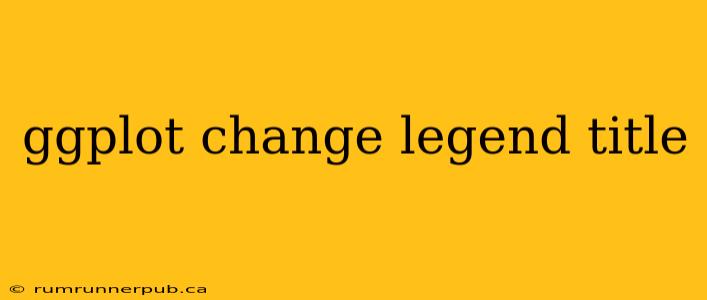ggplot2, a powerful data visualization package in R, offers a high degree of customization. One common task is modifying the title of the legend. This article will guide you through various methods, drawing upon insightful solutions from Stack Overflow, and adding practical examples and explanations to enhance your understanding.
Understanding the labs() Function
The most straightforward way to change a legend title in ggplot2 is using the labs() function. This function allows you to modify various aspects of your plot, including titles, axis labels, and, importantly, legend titles.
Example (based on common Stack Overflow solutions):
Let's say we have a simple scatter plot:
library(ggplot2)
# Sample data
data <- data.frame(x = rnorm(100), y = rnorm(100), group = factor(rep(c("A", "B"), each = 50)))
# Basic plot
p <- ggplot(data, aes(x = x, y = y, color = group)) +
geom_point()
#Adding the legend title
p + labs(color = "Group Name")
This code first creates a scatter plot with points colored according to the group variable. Then, labs(color = "Group Name") changes the legend title from the default ("group") to "Group Name". This directly addresses a frequently asked question on Stack Overflow regarding simple legend title changes.
Explanation: The labs() function uses the aesthetic mapping (here, color) as an argument. Whatever you assign to this argument becomes the new legend title. This is incredibly versatile; it works for fill, shape, and other aesthetics as well.
Dealing with Multiple Legends
When your plot involves multiple legends (e.g., using both color and shape), you'll need to specify the title for each aesthetic:
# Sample data with two grouping variables
data2 <- data.frame(x = rnorm(100), y = rnorm(100), group = factor(rep(c("A", "B"), each = 50)), shape_group = factor(rep(c("C","D"),50)))
p2 <- ggplot(data2, aes(x = x, y = y, color = group, shape = shape_group)) +
geom_point() +
labs(color = "Main Group", shape = "Secondary Group")
p2
Here, we've distinctly labeled the legends for both color and shape using labs(color = "Main Group", shape = "Secondary Group").
More Advanced Legend Customization (Inspired by Stack Overflow Solutions)
While labs() is sufficient for most cases, more complex scenarios might require additional techniques. For instance, if you need to add line breaks to your legend title, you can use the \n escape character within the title string (a solution often seen on Stack Overflow):
p + labs(color = "Group\nName")
This will create a legend title with a line break, improving readability for longer titles.
Conclusion
Modifying legend titles in ggplot2 is a common task, and Stack Overflow provides a wealth of solutions. The labs() function is the primary tool, allowing for straightforward title changes. By combining labs() with techniques like using escape characters for line breaks, you can achieve precise control over your legend's appearance, making your ggplot2 visualizations clear, informative, and aesthetically pleasing. Remember to consult Stack Overflow for more advanced scenarios and unique customization options not covered here. Always cite your sources and give credit where it is due!
